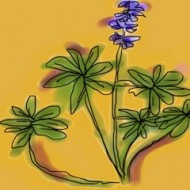The Dry Garden: Coyote mint
Paradise is at once so attainable and so far away.
This column was going to be about how the most immediate and affordable thing that Southern California homeowners could do to reduce our collective dependency on fossil fuel would be to rip out lawn. But events in the Gulf of Mexico are too crazy-making to be sure that it wouldn’t be the garden-writing equivalent of picking a fight at the dinner table. So this column is about coyote mint. Click here to keep reading The Dry Garden in the Los Angeles Times.…
The Dry Garden: Log love
Hackberry and coral tree wood gives loft to a bed with the hummingbird sage and an almost insect-like tendril of Artemisia californica (upper screen left). Photo copyright: Diane Cu / whiteonricecouple.com. Reprinted with permission.
In taking nature apart and putting it back together again in our gardens, we err toward the refined. This is the case with mulch. Nowhere is it written that it has to come chipped, much less in a bag from a store. In fact, there is much to be said for laying it down by the log.
Click here to keep reading today’s Dry Garden column on the beauty and benefit of deadwood in the garden. Or for full listings of dry garden events for June and July, click here.
Diane Cu’s photograph comes from this writer’s garden; on Cu’s first visit she was immediately struck by the texture and form of the deadwood and …
The Dry Garden: Undressing for summer
Bark hides in plain sight. Who needs the superhero power of invisibility when you’re constantly upstaged by flowers, fruit and foliage? It takes an event to draw the distracted eye to the trunk and limbs of a shrub or tree.
That event is happening now. With the summer solstice nigh, California’s best-adapted woody plants are slipping into dormancy to ride out the dry season. As they do so, still sated on spring rain, newly thickened by another year’s growth, the most wanton of the lot are shedding last year’s bark.
Click here to keep reading The Dry Garden on the beauty of bark in the Los Angeles Times.…
The Dry Garden: UCLA in theory and in practice
Stephanie Landregan, program director of the UCLA Extension Landscape Architecture & Horticulture program. Click on the image to find out about certificate courses. Photo: Emily Green
Nobody ever said that doing the right thing was easy. Students in UCLA Extension’s landscape architecture and horticulture program now learn this before leaving with a certificate. “All of our advanced design classes used to be make-believe,” said Stephanie Landregan, appointed program director two years ago. “Now every one of our advanced classes is involved with the community. Every one of our students has real projects and reality checks. The big ideas get tested.”
Just such a test happened in November, when an undergraduate from UCLA’s environmental science department contacted Landregan wanting to know how his class might introduce a water-efficient landscape somewhere on the 400-plus-acre campus. Landregan partnered his class with a group of her graduate extension students, and the team soon …
The Dry Garden: Matilija poppies
Two unrelated and equally magical things happen in Southern California in late May and early June. By night, courting mockingbirds sing all night. By day, the Matilija poppies begin their all-too-fleeting bloom. The shame is, while most everyone who sleeps becomes aware of the mockingbird’s song, not everyone with sight will encounter the Matilija, which is, without rival, the biggest, silliest, loveliest and most poignant of California wildflowers.
Click here to keep reading this week’s Dry Garden column in the Los Angeles Times.…
« go back — keep looking »

